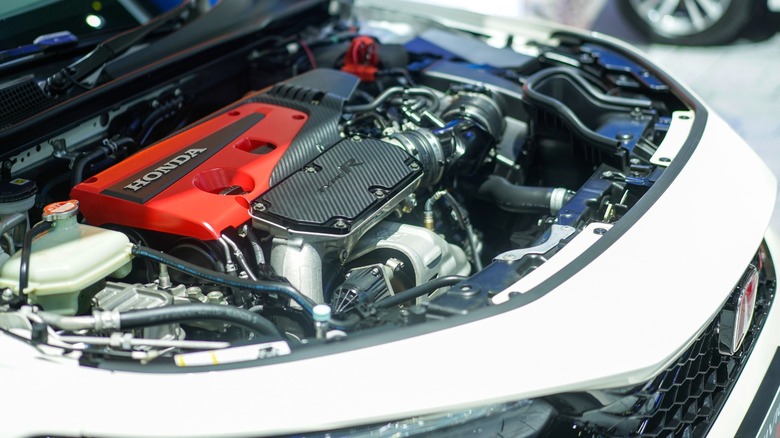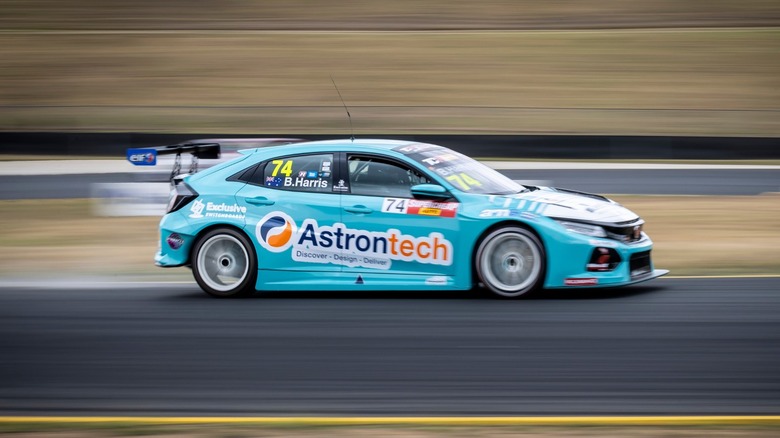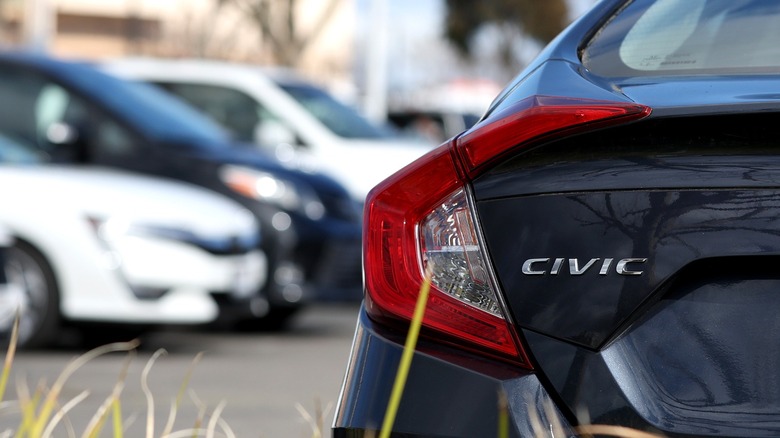Honda B-Series Vs. K-Series Engines: What's The Difference?
Honda is one of the most popular cars among tuners, especially the many generations of Honda Civics that you find in circuits and car shows. One of the reasons that the Civic (and other Honda vehicles) are in-demand as projects cars is the performance and reliability that some of its engines bring — especially, the B-Series and K-Series engines.
If you're building a Honda or Acura project car, you're probably wondering whether you should put a B-series or K-series engine in it — especially as some older Honda models can accept a newer K engine with some modification. Nevertheless, both engines are good candidates for putting in your project's engine bay. So, you might be wondering what's the difference between the two.
That why we're diving into the details of these two engines, which are also included in our list of the most reliable JDM engines ever. While we won't say which one is better for you — as there as are many other factors that you must consider besides the capabilities of the engine — you can at least get an idea of what you want with this comparison.
What is the Honda B-series engine?
The Honda B-series engine is the first engine family to get Honda's legendary variable timing electronic control (VTEC) technology, and was available from 1989 to 2001. It's a compact four-cylinder engine that first arrived in the 1989 Honda Civic SiR, which wasn't available in the U.S. The first American Honda to get the B-series engine was the 1994 Honda Civic Del Sol VTEC manual, while the first Honda Civic in the U.S. to get it was the 1999 Civic Si coupe. The Acura Integra did receive a B18 engine from 1990 to 1993, but it didn't have VTEC.
Aside from the 1.6-liter B16 engine, you can also get the B-series in other displacements, but the more popular ones are the B18 and B20 engines, which displaces 1.8 and 2.0 liters, respectively. Furthermore, while the B engine family was the first to feature VTEC, that doesn't mean that it's available across all its models.
Nevertheless, the B-family of engines, especially the B16 and B18 are loved by builders and enthusiasts become many of their parts are easily interchangeable. This means they won't have difficulty finding replacement and aftermarket parts to upgrade or keep their engine running in optimal conditions.
What is the Honda K-series engine?
The Honda K-series engine is the successor to the tuner-favorite B-series. It first appeared in the 2001 Honda Civic Type-R and Integra Type-R — which, unfortunately for us, didn't get to the U.S. Instead, our first taste of the K-series was with the K20A3 in the 2003 Honda Civic Si, which arrived stateside in 2002.
Despite being introduced over 20 years ago, you can still find a K-series engine in some current Honda models like the 2024 Acura Integra Type S, the 2024 Honda Civic Type-R, and 2024 Honda HR-V, which are powered by a K20C-series engine. This shows how Honda's engine technology evolved and matured from the B-series engine. This also meant that there are many different variants of this engine, as you can find it on different Honda sedan, crossover, and minivan models across multiple generations.
It's easier to buy OEM parts, especially because the K-series is still in production today. Furthermore, the popularity of the Honda models that has this engine family meant that it's easier to find aftermarket parts for it. Swapping in a K-series engine into a new car has grown so popular that we've seen some iconic cars from other manufacturers, like the iconic Mazda RX-7 and Mazda Miata, sport these engines.
Displacement differences
The biggest change between the B-series and K-series engine families is the availability of larger displacements. The smallest representative of the B-engine family is the B16, while its largest model, the B20, displaces two liters. On the other hand, the K-series engine family starts at two liters and goes up to 2.4.
The biggest displacement of the K-series means it can produce more power straight out of the box. For example, the last Honda Civic to get the B16 engine — the 2000 Honda Civic Si — produced 160 horsepower and 111 pound-feet of torque. On the other hand, the 2003 Honda Civic Si — which was the first USDM Honda to get a K20 engine — only had 160 horsepower. However, its engine provided greater torque at 132 pound-feet, allowing it to get up to speed much more quickly than the B16-powered Civic Si.
While turbo technology has allowed for small engines with high horsepower outputs, if you add a turbocharger to an engine with a larger displacement, you can get more power out of it than from a similar engine with smaller displacement. One of the things you should know about the K-series engine is that not all of them comes with a turbo from the factory. Nevertheless, their strength and reliability make them good candidates for an aftermarket forced induction upgrade.
VTEC availability
VTEC adjusts the engine's valve timing depending on the oil pressure, engine temperature, rpm, throttle position, and several other factors. So, if you're coasting down a neighborhood road, your engine is quiet and economical, but when you start pressing down the gas pedal on the racetrack, VTEC kicks in and you start getting more power from the same engine.
That is why the B16 engine has become so popular — its small size and VTEC technology means that it's a practical engine, but can still deliver the power you need when you step on the gas. However, not all B-engines have VTEC in them. For example, the 1990 to 1993 Acura Integra may come with a B18 engine, but it doesn't have Honda's valve timing technology. On the other hand, all K-series engines come with i-VTEC, which adds variable timing control to VTEC. This feature allows the engine to change the camshaft's timing to ensure that the opening and closing of the intake and exhaust valves do not overlap.
If you're buying an old Honda and the seller tells you that the car has a B-engine, you cannot automatically assume that it's equipped with VTEC. But if you're looking at a Honda or Acura vehicle with a K-engine, it will automatically come with Honda's venerable valve timing tech.
Which cars get which engines?
Now that we know the major differences between the B-series and K-series family, we'll list some of the most popular USDM Hondas that come with them from the factory. However, you should note that not all trims of the models we list may come with the noted engine, or the previous owner could have swapped it for another motor. So, you should always conduct your due diligence before purchasing any vehicle.
These are the American market Hondas and Acuras that come with a B-series engine: 1990 to 1993 Acura Integra (B18, non-VTEC), 1992 to 1993 Acura Integra GS-R (B17), 1994 to 1995 Honda Civic Del Sol VTEC (B16), 1994 to 2001 Acura Integra (B18), 1999 to 2000 Honda Civic Si Coupe (B16), and 1997 to 2001 Honda CR-V (B20, non-VTEC).
On the other hand, the K-series engine is available on more cars, especially given its longer lifespan. These are some of the Hondas and Acuras that come with a K-series engine, but we can't list everything because of the sheer numbers of models that have this engine.
You can find a K engine in the following USDM models: 2002 to 2006 Honda CR-V (K24), 2003 to 2004 Honda Civic Si (K20), 2004 to 2008 Acura TSX (K24), 2006 to 2010 Acura CSX (K20), 2007 to 2012 Acura RDX (K23), 2016 to 2021 Honda Civic (LX/EX models) (K20), 2017 to 2021 Honda Civic Type-R (K20), 2018 to 2022 Honda Accord 2.0 (K20), 2019 to 2024 Acura RDX (K20), 2021 to 2024 Acura TLX (except Type-S models) (K20), 2022 to 2024 Honda Civic (LX/Sport Models) (K20), 2023 to 2024 Honda Civic Type-R (K20), 2023 to 2024 Honda HR-V (K20), and 2024 Acura Integra Type-S (K20).





